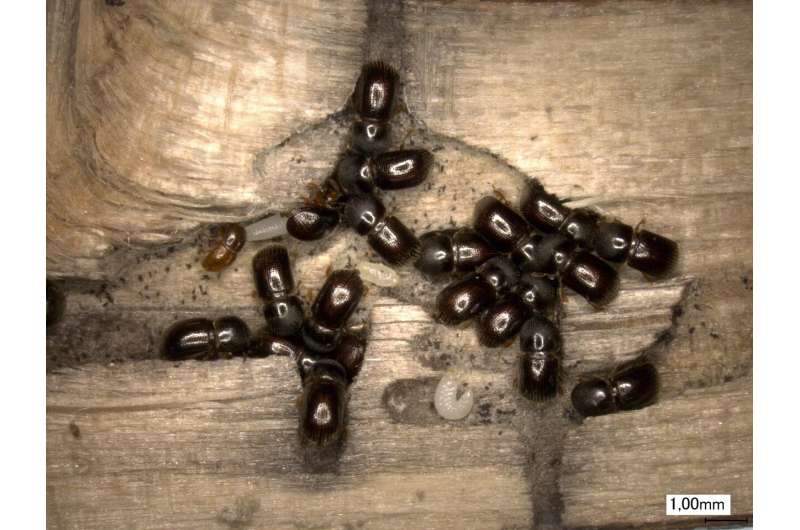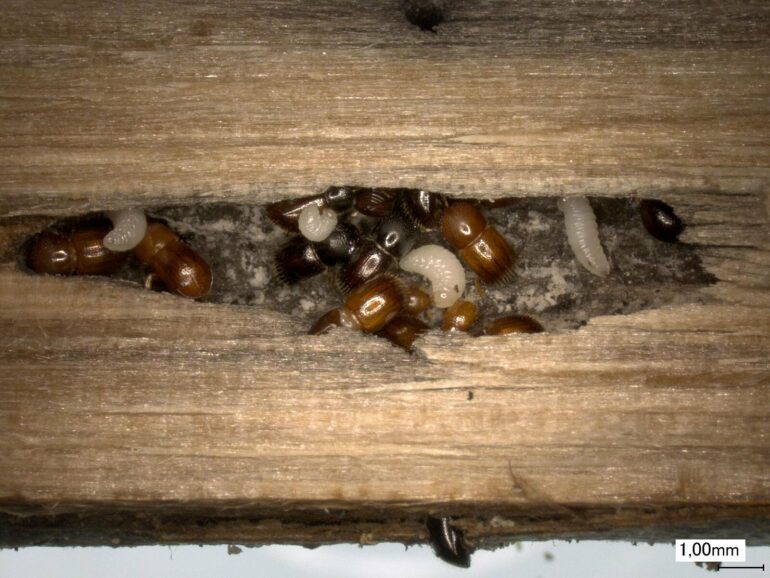The alnus ambrosia beetle Xylosandrus germanus, also known as the black stem borer, was accidentally introduced by humans from its native east Asia to North America and Europe around the beginning of the 20th century. X. germanus is a so-called ambrosia beetle, which means that it farms its own food, a specialized fungal symbiont that it “sows” and tends inside the galleries that it digs inside wood. The ambrosia beetle is a destructive invasive pest, known to attack more than 200 species from 51 families of broadleaf and conifer trees. While it prefers to colonize dead wood, it can also infest and ultimately kill weakened or stressed trees.
A proven way to monitor or even control insect pests is by hijacking their communication system and manipulating it to trap them to their doom. Females of the alnus ambrosia beetle are known to aggregate on individual trees, suggesting that they use chemical signals to find each other and identify suitable trees. Now, scientists have cracked this chemical code. The results are published in Frontiers in Microbiology.
“Here we show that the alnus ambrosia beetle doesn’t produce its own pheromones during tree-host colonization, but rather uses the volatile compounds of their own fungal symbionts to aggregate en masse and potentially kill trees,” said the study’s senior author Dr. Peter Biedermann, a professor at the Forestry Institute of the University of Freiburg in Germany.
First evidence of aggregation pheromones in ambrosia beetles
First author Antonio Gugliuzzo, a Ph.D. student at the Department of Agriculture, Food and Environment of the University of Catania in Italy, added, “This is the first evidence for the existence of aggregation pheromones in ambrosia beetles of the tribe Xyleborini.”
Like all ambrosia beetles, X. germanus females carry their fungal symbionts in special pockets inside their head. The study authors used molecular methods to culture and identify the two most common symbionts as Ambrosiella grosmanniae, most likely the beetles’ primary food source, and an unknown species of Acremonium that the beetles may or may not eat. In 2020, the researchers caught mated dispersing X. germanus females near Freiburg, and allowed them to dig galleries in an artificial medium based on beech sawdust, grow these two fungi, and rear their offspring.
They then used these fungi as bait in two-choice experiments in an apparatus called a still-air olfactometer. Here, X. germanus females were placed in an arena with two dead ends to enter and hide in; for example, one containing an isolate of the two symbionts A. grosmanniae and Acremonium sp., and another with an isolate of an unrelated fungus expected to be unattractive to the beetles—here, an uncharacterized Cladosporium species. The beetles’ preference would depend on their relative attraction to microbial volatile organic compounds (MVOCs) released by the fungi.
In a variant of this experiment, previously healthy beech branches infected with different fungi were presented to the beetles as options for choice.

Alnus ambrosia beetles (Xylosandrus germanus) in their galleries, tending the brood and fungus. © Antonio Gugliuzzo
Beetles prefer odor of symbionts and colonized branches
The results showed that the beetles were most attracted to A. grosmanniae MVOCs and least to Cladosporium MVOCs, and more to branches already colonized by A. grosmanniae than to uncolonized branches. The authors conclude that X. germanus uses MVOCs released by its two symbiont strains as a “synomone”—a chemical signal that benefits both the emitter like and the receiver.
“Occupied tree branches may signal the beetles suitable substrate for the food fungi they depend on. This suitability is probably a delicate balance: trees need specific requirements to allow the beetles to farm the fungus successfully,” said Biedermann.
“But this isn’t an absolute requirement: If a female can’t find any conspecifics, or detect any MVOCs, she could still independently colonize a new tree branch.”
Promising avenue for biological control
These results immediately suggest a new method for biological control.
“Now that we know that the fungi produce attractive volatiles, we may be able to develop new trapping lures for the beetles on the basis of these compounds,” said Biedermann.
“Moreover, the use of specific volatile compounds for trapping purposes could contribute to the development of innovative and selective trapping methods targeting specific ambrosia beetle species, thereby minimizing catches of non-target arthropods living in the same environment.”
More information:
Volatiles of fungal cultivars act as cues for host-selection in the fungus-farming ambrosia beetle Xylosandrus germanus, Frontiers in Microbiology (2023). DOI: 10.3389/fmicb.2023.1151078 , www.frontiersin.org/articles/1 … cb.2023.1151078/full
Citation:
Farmer beetle finds suitable host trees by tracing scent of its fungus crop (2023, April 14)


